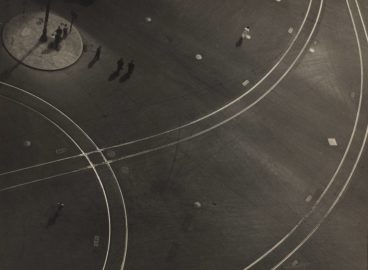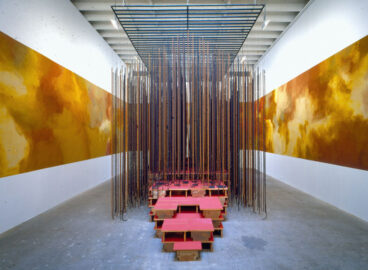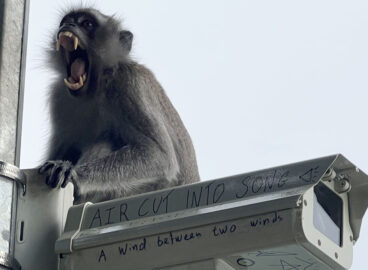Temptations to pronounce a politics of ecology and technology are incisively moderated in this essay on Tetsumi Kudo’s multimedia installation, presented in MoMA’s Gallery 420 through the fall, prompting a broader critical commentary on the negotiations of cultural typification and belonging in the artist’s oeuvre.
Like an unskilled piece of ikebana, lurid and writhing plastic flowers stick out of the horizontally laid triangular prism in Pollution—Cultivation—New-Ecology Underground (1972–73) by Kudo Tetsumi (1935–1990). The rough texture of the black soil plastered onto the base—whose surface is occasionally broken up by bristles of artificial grass and drools of resin—and the lumps of hair tangled in the flowers evoke intense hapticity. Yet the work’s eventual preference for the eye is reinforced when, through three plexiglass windows located on the frontal panel of the base, one voyeuristically peeks into an interior in which a subterranean city built upon a circuit board flourishes in a climate-controlled underworld, a biomechanical society seemingly detached from the post-apocalyptic life above ground where gnarled vegetation manages to survive only sparingly. Pollution—Cultivation—New-Ecology Underground is a speculative image of a hypogeal future, in which irreversible radioactive pollution has made epigeal life on Earth nearly impossible. Inside the darkly lit enclosure, a cord irradiating red, yellow, and orange coils around a penis towering over a verdant field of polyester flora; freeways of electrical wires crisscrossing a densely packed urban topography consisting of transistors, resistors, capacitors, inductors, and relays converge at a crimson brain nested in a bed of cerulean moss. On one end of this landscape of grotesquerie, flies feast on a mustard yellow turd, while on the other, a heart-shaped figure fluoresces in pink and green. A toy snail, bird, frog, eyeball, and cockroaches fashioned out of plastic also dot this vista overseen by a gray scrotum hanging conspicuously just below a black light fixed to the ceiling, the sole source of ultraviolet light giving this gaudy and kitsch diorama its iridescent glow.
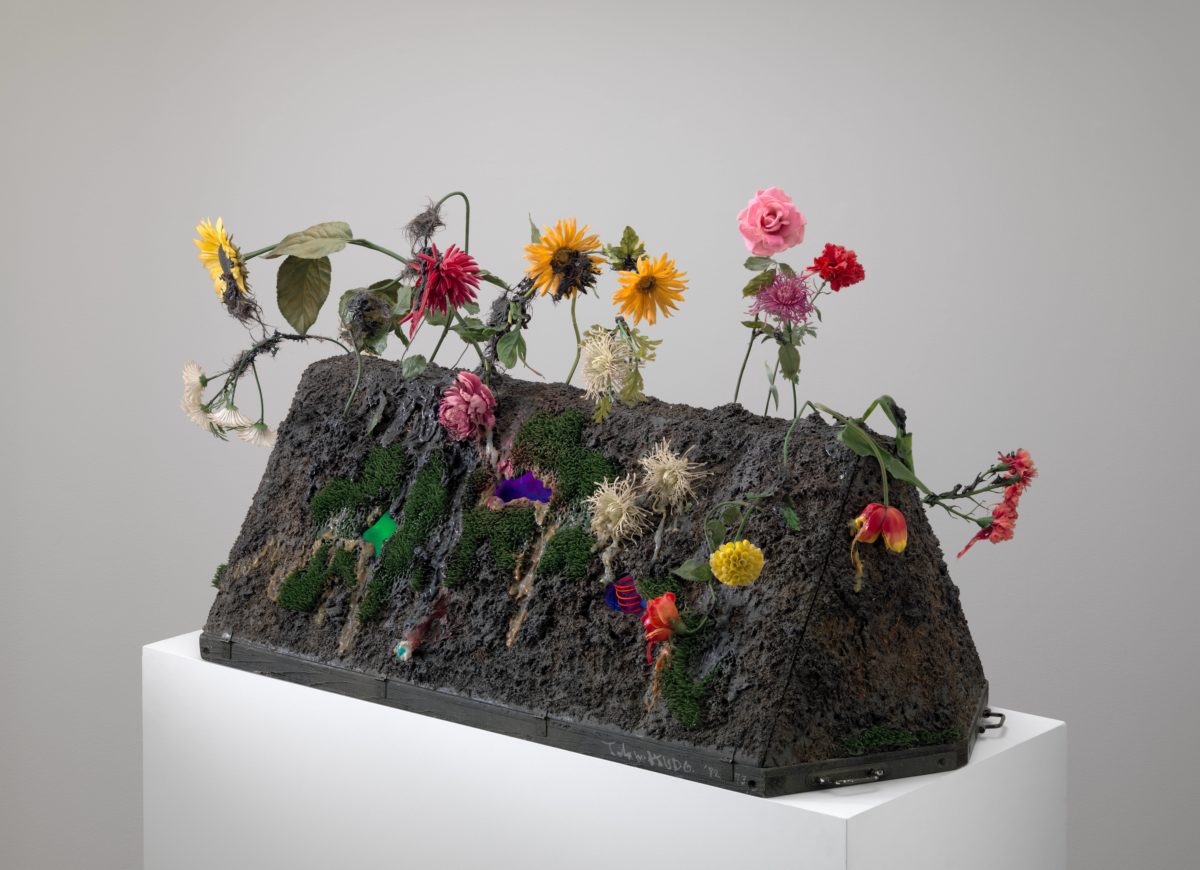
The exuberant anarchy of Kudo’s work in the late 1950s and early 1960s ebbs in this meticulously organized piece, though his phallic motif most spectacularly displayed in Philosophy of Impotence, or Distribution of Map of Impotence and the Appearance of Protective Domes at the Points of Saturation (1961–62)—an early installation in which Kudo first advanced impotent male (a)sexuality as a concept of disempowerment and disavowal of biological reproduction—remains very much at the core. His transition to a more measured and inward style in the 1970s is not a sudden rejection of his earlier predilection for exteriority but concludes the formal investigation into the psychosomatic effects of technology and commodity he had been conducting since the 1960s.1Kudo uses “protective dome” to interpret the condition of advanced or western society. See Masuda Tomohiro, “When the Box Is Presented to You: Tracing the Development of Tetsumi Kudo in Paris, 1962,” in Your Portrait: A Tetsumi Kudo Retrospective, exh. cat. (Osaka: National Museum of Art, 2013), 439. Two sculptures from 1964, Love and Your Portrait, are good cases in point. Anthropomorphic contours of the ego are reduced to sensory organs such as lips, ears, eyes, nose, hands, and brain, which the consciousness industry has deemed essential to consumption. Your Portrait—Chrysalis in the Cocoon (1967) and Homage to the Young Generation—The Cocoon Opens (1968) then gather and shelter these parts, overstimulated in a commodity-saturated environment, in incubatory cages and cocoons that manage their cognitive intake through feeding tubes. These works describe the mutual dependence of market expansion, relentless consumption, and psychic retreat. But instead of conspiring to break out of confinements, Kudo repurposed these containers as self-sustaining ecological architectures designed to break off from the inward-looking autochthonous (ethnocentric or nativist) society he discovered in Paris upon his arrival in the early 1960s.
Kudo’s formal inclinations toward the interior and dismembered body parts do not intuitively resonate with the use of organic substances and specific sites outside the museum in the ecologically oriented praxes of his contemporaries, such as Joseph Beuys (1921–1986), Robert Smithson (1938–1973), Ana Mendieta (1948–1985), and Suga Kishio (born 1944). Kudo’s flirtatious references to nature and his uncouth aesthetics of “junk art” labor rather awkwardly under the ethical banner of ecology. Reminiscent of the miniatures Marcel Duchamp (1887–1968) stuffed in a suitcase, the diminutive “souvenirs” populating the hold of Pollution—Cultivation—New-Ecology Underground are no more natural than cars or cryptocurrency; polyester flowers mass-produced primarily for ornamental pleasure are a species of plant wholly separate from their biological model. If land art seeks to rekindle the links between art, humans, and nature—though sometimes in a hegemonic manner—then Kudo’s overt use of ersatz nature modestly curtails such hope by betting on the fact that art is ultimately an exercise in inorganic artificiality, a discourse of departure, not return. His works constitute a parade of obvious and inferior fakes: the countless phalli in his oeuvre are generic types; the semen in Instant Sperm (1962) was a concoction of yogurt and vodka; his employment of the term “cybernetics” in the early 1960s to describe the mechanization of organic life is an enticing though superficial gesture; the technological machineries in his works are never quite functional; the Your Portrait series proliferates alternative personas that he in turn occasionally impersonates. He risks his being as an impoverished facsimile that circumvents the real, and in doing so subtly ridicules the facetious nativism underwriting the alliance of art and nature. The destiny of art is the fake. Few artists have dared to envision ecology through such a trajectory.
The fake as an inorganic thing not only evades the question of ancestral or autochthonous origin, it also complicates the ethical synthesis of humans and nonhumans. His promiscuous amalgamations of insentient objets, anthropomorphic signs, and machinic parts satirize the reconciliation of “the two contractual obligations, social and natural,” which French philosopher Michel Serres believes will bind “men [sic] to the world and the world to men [sic]” and keep total environmental calamity at bay.2Michel Serres, The Natural Contract (Ann Arbor: University of Michigan Press, 1995), 50. Although the flesh I reference here draws on the work of Akasegawa Genpei (1937–2014) in the early 1960s, I am also inspired in part by the flesh invoked in Alexander G. Weheliye, Habeas Viscus: Racializing Assemblages, Biopolitics, and Black Feminist Theories of the Human (Durham: Duke University Press, 2014). For how the flesh functions in Akasegawa’s work, see William Marotti, Money, Trains, and Guillotines: Art and Revolution in 1960s Japan (Durham: Duke University Press, 2013). In further mockery of this posthumanist effort to diligently suture and dress the wound, which “the anthropological machine” has inflicted upon the ontological tissue linking humankind to nature, Kudo draws up, as sculptures and reliefs, an unnatural contract that invokes the monstrous mixtures of the alien flesh against the juridically legible, rational human body.3Giorgio Agamben, The Open: Man and Animal (Palo Alto: Stanford University Press, 2003). For a posthumanist method of crossing the yawning gap separating nature and culture, see Bruno Latour, We Have Never Been Modern, trans. Catherine Porter (Cambridge, MA: Harvard University Press, 1993). In contradistinction to conservative humanists who have elected to maintain this divide as a monument to modern reason against the posthumanist attenuation of anthropocentrism, Kudo further deepens the cut to completely exsanguinate the exclusionary image of humanity until all categories of assimilation—such as nationality, ethnicity, religion—lie lifeless before the bodies and copies once deemed illegitimate by those notions.4See, for instance, Luc Ferry, The New Ecological Order (Chicago: University of Chicago Press, 1995) for a humanist reaction to posthuman propositions. To get a better understanding of how the notion of assimilation proceeds through exclusion, see Denise Ferreira da Silva, Toward a Global Idea of Race (Minneapolis: University of Minnesota Press, 2007).
The portrait of a Japanese transplant artist who made a name for himself abroad by willingly rehashing the cheap mystical semiotics of hara-kiri, ikebana, and nuclear exposure for the western gaze obscures the connection between ecology and the fake. A more useful though imperfect frame would be that of an immigrant—as opposed to an expatriate—who must survive in a foreign environment. If this perspectival shift is indeed appropriate in reading his movement, then the motif of interiority frequently deployed in his écologie is less an allegory of capitalist mentality or bourgeois solipsism than an internal system designed to harness the energy of displacement. Kudo the Déraciné was not fully Japanese, French, or cosmopolitan. Even though he was more or less a privileged international traveler, he considered himself a perennial outsider and never felt comfortably at home anywhere.5For an overview of Kudo’s move to Paris and the sense of displacement he expressed during his brief return to Japan, see Doryun Chong, “When the Body Changes into New Forms: Tracing Tetsumi Kudo,” in Tetsumi Kudo: Garden of Metamorphosis, ed. Doryun Chong, exh. cat. (Minneapolis: Walker Art Center, 2008), 24–49. The reference to ikebana in Pollution—Cultivation—New-Ecology Underground , then, is not an example of cultural identity or nostalgia so much as an ironic transformation of the traditional Japanese genre of floral arrangement into a nihilistic performance of deracination from a natal soil, of the break that had rendered him always alien, set apart.
This separation certainly did not trigger a desire in Kudo for a stronger communal belonging. Rather, Pollution—Cultivation—New-Ecology Underground is a competing and agonistic image of the displaced imagined against the western monopoly on humanity and globality. As though a prop from a speculative fiction about a failed world after environmental collapse, this severed patch of burned-out soil untethered from nation and blood is a pseudo-mechanical underground vessel tunneling the uncertain depth of allochthony to flee the terrestrial politics of autochthony. Although the connection may be somewhat tenuous without further qualification, immigrants partially inherit the forcible extraction of peasants from their land that prefaced their historical transformation into a class of proletariats.6Yi Jinkyung, “From an East Asia of Wokou to an East Asia of Displaced Persons,” https://leviathan-cycle.com/essays/from-an-east-asia-of-wokou-to-an-east-asia-of-displaced-persons/. In that sense of Entfremdung (alienation) and becoming, the ecology Kudo conjured up is not a preventive measure to stave off pollution but rather a complex amalgamation of dissonant and deterritorialized parts assembled to secure autonomy after social identity, national management, and terrestrial belonging have malfunctioned on both ideological and practical levels.7See Franco “Bifo” Berardi, The Soul at Work: From Alienation to Autonomy (Los Angeles: Semiotext(e), 2009). That is to say, there is an ecology that autochthonous subjects (e.g., European and American humanists or Christians) openly espouse as they make themselves comfortably at home (oikos) in the world, and another ecology that allochthonous déracinés (e.g., antihumanists) discretely dream about amid social limitations. However, the antagonistic dichotomy of humanism and antihumanism Kudo rhetorically evoked to stage this conflict (likely perceived as an orientalist binary of east and west by his European interlocutors) overshadows the subtler line his language actually draws between the auto-humanism of western autochthons and the allo-humanism of allochthons, or outsiders adrift who must constantly negotiate their place in the world.8See Kudo Tetsumi, “Dear Mr. Beeren (Dear Europeans)” and “Pollution—Cultivation—New Ecology,” in Tetsumi Kudo: Garden of Metamorphosis, 101–4, 130–31. Pollution—Cultivation—New-Ecology Underground sides with the latter’s migratory claims, in opposition to the former’s aesthetics of proprietorship.
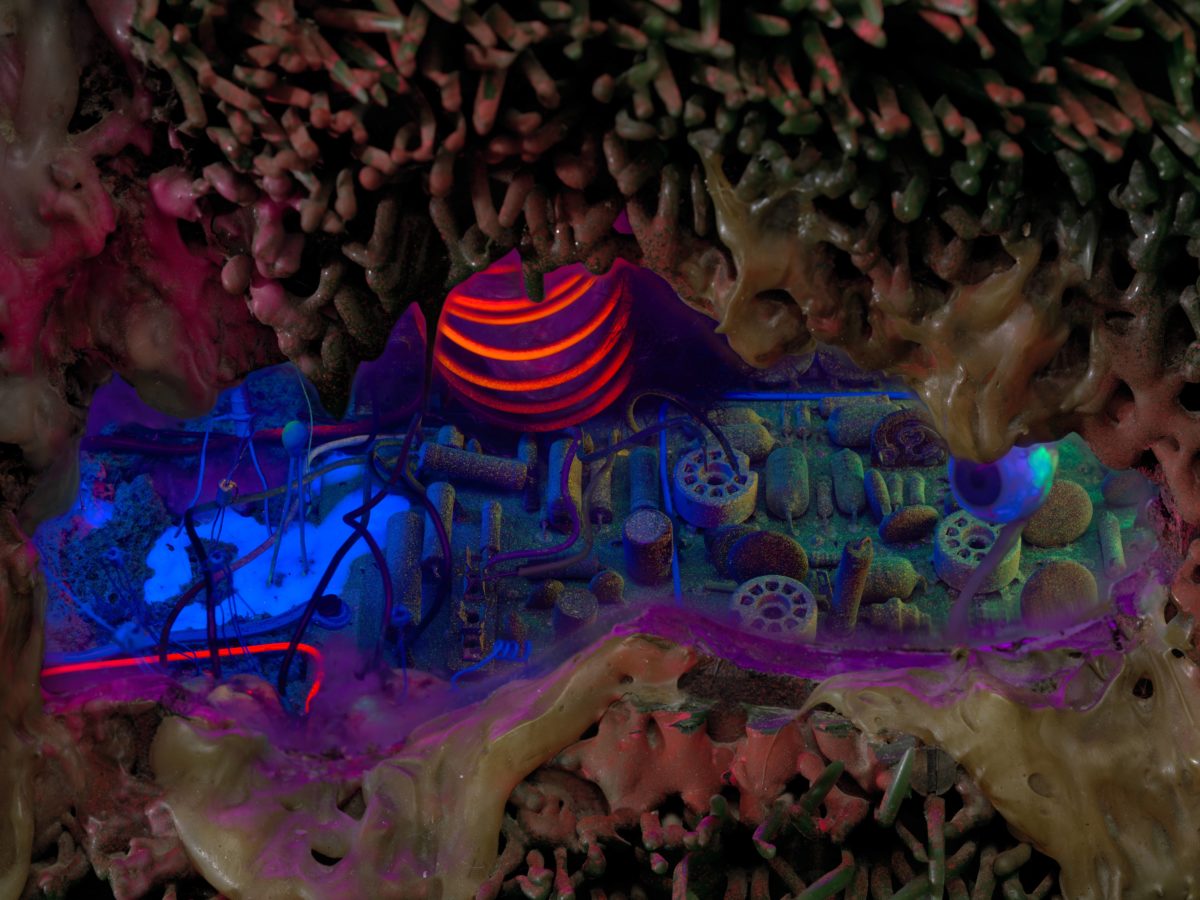
The fact that the three plexiglass windows keep certain aspects of the interior hidden from view contradicts the expectations fulfilled by the technologically superior ecological optics saturating contemporary media. High definition, “state-of-the-art” documentaries such as BBC’s Planet Earth (2006) and Planet Earth II (2016) cynically demonstrate that public understanding of nature occurs concurrently with advancements in the ability to surveil and impose an anthropomorphic gaze onto the very things people allegedly want to protect. There is probably nothing more damaging to the cause of ecology than digital reproductions with which nature, as an economic and technological relation of images, must fiercely compete.9The context is different, but Hito Steyerl, “In Defense of the Poor Image” and “The Spam of the Earth: Withdrawal from Representation,” in The Wretched of the Screen (Berlin: e-flux, 2012), 31–45, 160–75, have informed my thinking on this matter. The proliferating panoramic landscapes on UHD screens belie the fact that nature is rapidly diminishing; relentless deforestation and costly wildfires radically compromise nature’s ability to keep up with its visually enhanced and immensely lucrative doubles cinematically generated as part of the market’s aggressive pursuit of consumer attention. Viewers hardly notice the electric signals coursing through circuit boards and wires behind each tree, stream, and animal they witness in stunning detail. Somewhere in this techno-commercial imagination, the immaculate optics of high-resolution capture become synonymous with clearing pollution and removing allochthonous elements to reinstate virginal sights. Contrary to this eco-humanist chimera, the inept entwining of mechanical parts, biological signs, and plastic objects in Pollution—Cultivation—New-Ecology Underground openly owns up to the polluted mixture without which no delivery of images would be possible. To see is to dirty. Further, the high-angle satellite view of documentaries like Planet Earth presumes that all points on the globe are immediately accessible, conflating hygienic ecological vision with that of intercontinental ballistic missiles ready to launch at any enemy target.10I have in mind the arguments presented in Hito Steyrel’s How Not to Be Seen: A Fucking Didactic .MOV File (2013). Far from picturing a humanist stewardship of Earth, this ultra-expanded field of borderless scenery is a proxy for imperial visuality. As opposed to this pious, optical ascension beautifully promoted in high ecology, the openings on the slanted base of Pollution—Cultivation—New-Ecology Underground frame, in a downward angle, a darkening descent to low ecology.
Contrary to the eco-eye that assumes a frictionless mobility across a seemingly infinite territory, Pollution—Cultivation—New-Ecology Underground articulates the discretely withdrawn and immobile aesthetics of frein vital (a constraining of life), a notion that Japanese critic Hanada Kiyoteru (1909–1974; whose writings in the 1950s Kudo could not have been unaware of) proposed against the élan vital of liberal capitalism. Élan wants to always expand, whereas frein actively relinquishes that wish.11Hanada Kiyoteru, “Élan and Frein,” in Collected Writings of Hanada Kiyoteru, vol. 4 (Tokyo: Kōdansha, 1977), 530–38. Hanada’s theory takes on an additional register in Kudo’s work: an ascetic and external withdrawal that proceeds through severing ties with nation, humanity, and origin founds a lowly world replete with fakes whose existence and identity are not evaluated and judged upon their distance from, or proximity to, origin or home. If high ecology treats optically enhanced representations of nature as proxies of the real, or encourages the incorporation of organic matter into artistic practice to forge an alliance between human expression and nonhuman nature, low ecology accepts fakes as legitimate actants of a speculative planetary composition. These poor duplicates are not secondary representatives of the real but constitute beings in and of themselves. This is how Kudo carries over into the ecological the potential Walter Benjamin saw in mechanical reproducibility.12Walter Benjamin, “The Work of Art in the Age of Mechanical Reproduction,” in Illuminations, ed. Hannah Arendt (New York: Schocken Books, 1968), 217–51. Fakes pollute the real, the aura, just as immigrants and the other “pollute” the authentic humanism of the few. The division between real and fake, good copy and bad copy, therefore, is tantamount to the one problematically presumed between native and immigrant, autochthonous and allochthonous.13Gilles Deleuze, “The Simulacrum and Ancient Philosophy,” in The Logic of Sense (New York: Columbia University Press, 1990), 253–79. New-Ecology as low ecology rejects the xenophobic danger lurking in the hieratic and assimilationist auto-humanism that seeks to subsume all life on Earth. Turning away from the facetious promises of the Same, the motley crew of déracinés aboard a subterranean vessel called Pollution—Cultivation—New-Ecology Underground navigates a peripheral, hypogeal ocean in search of a heretic shore where fakes deemed subordinate are admitted as equals without question and able to pursue transformative life. This allo-humanist fantasy demands not power but impower or, as Kudo has always insisted, impotence.
- 1Kudo uses “protective dome” to interpret the condition of advanced or western society. See Masuda Tomohiro, “When the Box Is Presented to You: Tracing the Development of Tetsumi Kudo in Paris, 1962,” in Your Portrait: A Tetsumi Kudo Retrospective, exh. cat. (Osaka: National Museum of Art, 2013), 439.
- 2Michel Serres, The Natural Contract (Ann Arbor: University of Michigan Press, 1995), 50. Although the flesh I reference here draws on the work of Akasegawa Genpei (1937–2014) in the early 1960s, I am also inspired in part by the flesh invoked in Alexander G. Weheliye, Habeas Viscus: Racializing Assemblages, Biopolitics, and Black Feminist Theories of the Human (Durham: Duke University Press, 2014). For how the flesh functions in Akasegawa’s work, see William Marotti, Money, Trains, and Guillotines: Art and Revolution in 1960s Japan (Durham: Duke University Press, 2013).
- 3Giorgio Agamben, The Open: Man and Animal (Palo Alto: Stanford University Press, 2003). For a posthumanist method of crossing the yawning gap separating nature and culture, see Bruno Latour, We Have Never Been Modern, trans. Catherine Porter (Cambridge, MA: Harvard University Press, 1993).
- 4See, for instance, Luc Ferry, The New Ecological Order (Chicago: University of Chicago Press, 1995) for a humanist reaction to posthuman propositions. To get a better understanding of how the notion of assimilation proceeds through exclusion, see Denise Ferreira da Silva, Toward a Global Idea of Race (Minneapolis: University of Minnesota Press, 2007).
- 5For an overview of Kudo’s move to Paris and the sense of displacement he expressed during his brief return to Japan, see Doryun Chong, “When the Body Changes into New Forms: Tracing Tetsumi Kudo,” in Tetsumi Kudo: Garden of Metamorphosis, ed. Doryun Chong, exh. cat. (Minneapolis: Walker Art Center, 2008), 24–49.
- 6Yi Jinkyung, “From an East Asia of Wokou to an East Asia of Displaced Persons,” https://leviathan-cycle.com/essays/from-an-east-asia-of-wokou-to-an-east-asia-of-displaced-persons/.
- 7See Franco “Bifo” Berardi, The Soul at Work: From Alienation to Autonomy (Los Angeles: Semiotext(e), 2009).
- 8See Kudo Tetsumi, “Dear Mr. Beeren (Dear Europeans)” and “Pollution—Cultivation—New Ecology,” in Tetsumi Kudo: Garden of Metamorphosis, 101–4, 130–31.
- 9The context is different, but Hito Steyerl, “In Defense of the Poor Image” and “The Spam of the Earth: Withdrawal from Representation,” in The Wretched of the Screen (Berlin: e-flux, 2012), 31–45, 160–75, have informed my thinking on this matter.
- 10I have in mind the arguments presented in Hito Steyrel’s How Not to Be Seen: A Fucking Didactic .MOV File (2013).
- 11Hanada Kiyoteru, “Élan and Frein,” in Collected Writings of Hanada Kiyoteru, vol. 4 (Tokyo: Kōdansha, 1977), 530–38.
- 12Walter Benjamin, “The Work of Art in the Age of Mechanical Reproduction,” in Illuminations, ed. Hannah Arendt (New York: Schocken Books, 1968), 217–51.
- 13Gilles Deleuze, “The Simulacrum and Ancient Philosophy,” in The Logic of Sense (New York: Columbia University Press, 1990), 253–79.

